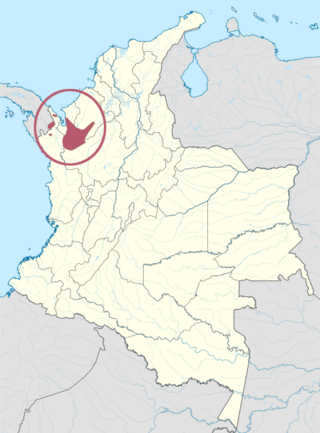| Catío | |
|---|---|
| Emberá-Catío | |
| Native to | Colombia, Panama |
Native speakers | (15,000 cited 1992)[1] |
| Language codes | |
| ISO 639-3 | cto |
| Glottolog | embe1260 |
| ELP | Emberá-Catío |
 | |
Catío Emberá (Catío, Katío) is an indigenous American language spoken by the Embera people of Colombia and Panama.[2]
The language was spoken by 15,000 people in Colombia, and a few dozen in Panama, according to data published in 1992.[2] 90 to 95% of the speakers are monolingual with a 1% literacy rate.[2] The language is also known as Eyabida, and like most Embera languages goes by the name Embena 'human'.[2]
Writing system
[edit]Catio is written with the Latin script.[3]
| a | ã | e | ẽ | i | ĩ | o | õ | u | ũ | ʉ | ʉ̃ |
| m | k | b | p | t | ch | s | z | g | j | r | rr | d | n | y | w | ñ |
Phonology
[edit]Consonants
[edit]| Bilabial | Alveolar | Palatal | Velar | Glottal | ||
|---|---|---|---|---|---|---|
| Plosive/ Affricate |
aspirated | pʰ | tʰ | t͡ʃʰ | kʰ | |
| ejective | pʼ | tʼ | t͡ʃʼ | kʼ | ||
| voiced | b | d | d͡ʒ | |||
| Fricative | aspirated | sʰ | h | |||
| ejective | sʼ | |||||
| Nasal | m | n | ||||
| Rhotic | trill | r | ||||
| tap | ɾ | |||||
| Semivowel | w | |||||
Vowels
[edit]| Front | Central | Back | ||
|---|---|---|---|---|
| unrounded | rounded | |||
| High | i ĩ | ɯ ɯ̃ | u ũ | |
| Mid | e ẽ | o õ | ||
| Low | a ã | |||
Notes
[edit]- ^ Catío at Ethnologue (18th ed., 2015) (subscription required)
- ^ a b c d Catio language at Ethnologue (12th ed., 1992).
- ^ Silva Vallejo & Majore 2018, p. 77-78.
- ^ a b Mortensen, Charles Arthur (1994). Nasalization in a revision of Embera-Katio phonology (MA thesis). Arlington: University of Texas.
Bibliography
[edit]- Silva Vallejo, Fabio; Majore, Iván Antonio Dominico (2018). "Los emberá katio del Alto Sinú-Córdoba". Oraloteca (in Spanish). 9: 64–84.
Well, that’s interesting to know that Psilotum nudum are known as whisk ferns. Psilotum nudum is the commoner species of the two. While the P. flaccidum is a rare species and is found in the tropical islands. Both the species are usually epiphytic in habit and grow upon tree ferns. These species may also be terrestrial and grow in humus or in the crevices of the rocks.
View the detailed Guide of Psilotum nudum: Detailed Study Of Psilotum Nudum (Whisk Fern), Classification, Anatomy, Reproduction